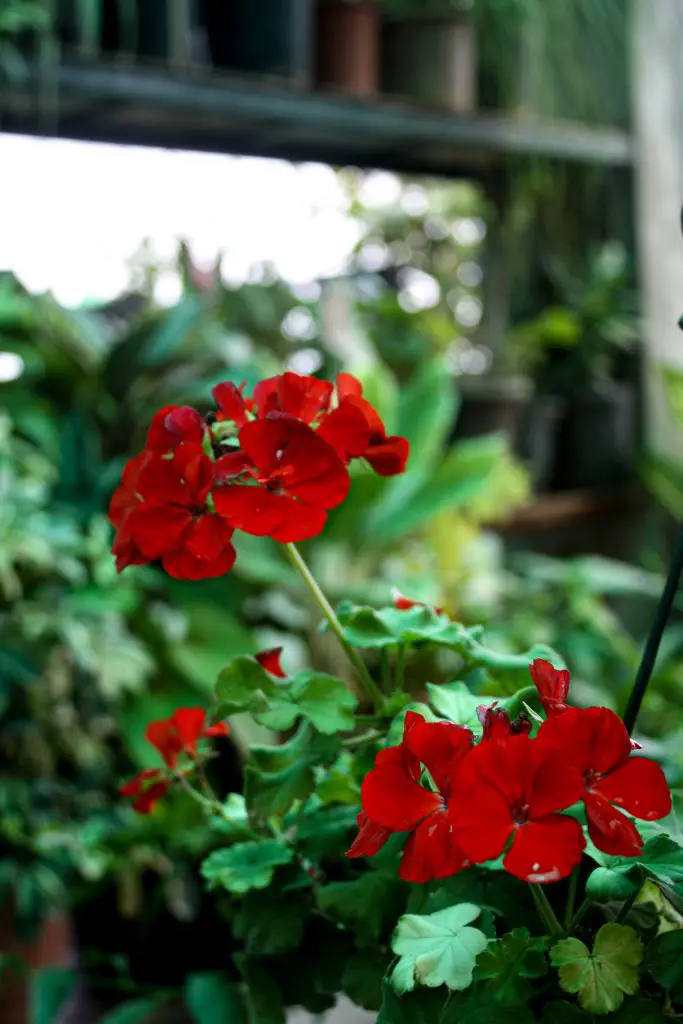Do Deer Eat Geraniums? And How To Protect Them Geraniums are a popular cottage garden plant that has been used for over 200 years to create beautiful bedding displays. The plants were popularized in the mid 1800s in the UK when colourful bedding displays became a fashion statement. Since that time geraniums have become a mainstay of many cottage gardens around the world, however, if you live in an area that has a large deer population can you grow geraniums successfully or will they eat them?
Geraniums are generally considered to be relatively deer resistant plants that will only be eaten in cases where there is little else on offer or there is a very large number of deer present in your area. Some sources even stated that geraniums have deer repellent properties which means that they can be positioned strategically to discourage deer from entering your garden.
To maximise the effect of plants that have deer resistant properties it is ideal to plant them on the outer part of your garden as that will deter the animals from entering your property. These plants can be used in combination with other deer repellent plants such as lavender and rosemary.

As a general rule, deer do not like plants that are either fragrant, toxic, or prickly in nature. However, these are only general guides and if you wish to see a comprehensive list try visiting the New Jersey Agricultural Experimentation Station website which has advice on hundreds of different plants.
However, it is important to note that deer are extremely persistent pests and can cause a lot of problems in your garden therefore it is generally a good idea to put in place additional protections because not every plant in your garden will be deer resistant.
How To Protect Your Garden From Deer
Due to the persistent nature of the deer, there is really only one 100% effective method to stop them from attacking your garden which is to exclude them. This can be done by erecting a fence that is approximately 8 ft tall. The height of this fence may seem excessive however academic studies have shown that deer can comfortably jump a 6-ft fence without too many problems.
However, using a fence can be extremely cost prohibitive or even impractical for some gardeners due to the lay of the land in their garden. So what are the alternatives?
The easiest thing to do is designed a garden to discourage deer from entering them in the first place by selecting plants such as geraniums to plant in the outer part of the garden which will discourage them from entering it in the first place. When selecting plants to do this it is ideal to choose ones that are relatively tall to make it more difficult for the deer to see into your garden where you may have plants that are more tempting for them to eat.

Conversely, if you have any plants that are known to be attacked by deer it is best to try and plant them close to your house as your day-to-day activities will deter them from hanging around in that general area at least during the day.
The other option commonly used is to purchase deer repellent products which can be divided up into 2 major groups, chemical repellents and mechanical ones. Based on the academic studies I have seen chemical repellents generally seem to be more effective than mechanic ones.
Chemical Deer Repellents
Chemical deer repellents do vary in their effectiveness depending on the nature of how their formulated. These types of products can generally be classified into three different groups fear-inducing, pain-inducing and repellents that generally repel the plants through smell and taste.
Of these three groups, the most effective according to academic research is fear-inducing repellents, however, even though these repellents have been shown to be quite effective they have limitations in how long they can be used.
Studies have shown that even the most effective deer repellents will only last for approximately 10 to 12 weeks before the plants begin to become acclimatized to the smell. Once this happens the deer will progressively return to their normal feeding habits over time.
Fear-inducing repellents are based upon ingredients such as coyote urine, blood, and putrified egg. The putrified egg is effective in this application because it emits odours that are similar to those emitted by common predators.

As such we recommend that you purchase at least two different deer repellents so that they can be alternated. The two products that we usually recommend are deer out and plantskydd because they are both fear-inducing products that are based on different ingredients which means that they will smell different. To see the latest price click on the links above to visit Amazon.
Mechanical Repellents
Like chemical repellents, there is a range of different devices available which can generally be categorised into motion-activated sprinkler systems, ultrasonic products, and products such as predator eyes which are designed to mimic the eyes of a predator at night.
Of these devices that are available the most effective is the motion-activated sprinkler, however, like the chemical repellents deer can quickly become accustomed to their use so for them to be effective it is important to use them sparingly in your garden.
We recommend regularly changing the position of the sprinklers and also periodically turning them on and off to ensure that the deer do not become too used to their presence.
In terms of the products themselves the product we would recommend is the Orbit 62100 Yard Enforcer because it has a 40ft detection range and a 120-degree view which means that a single sprinkler can cover a large area. To see the latest price on these devices on Amazon click on the link above.
The second type of mechanical device that is commonly offered in the marketplace is the ultrasonic devices. These devices have been extensively studied by researchers in academia and they have universally been found to be extremely ineffective at preventing animals from entering your garden.

And while many manufacturers state that these devices are effective against a large number of creatures including deer and rodents the reality is that academic research has struggled to find even a mechanism for how these products may affect the animals and their studies have shown that they have no impact upon the animals behaviours at all. As such we do not recommend that you purchase a device of this nature.
The third type of device which is commonly used is predator eyes. There has been very little academic research conducted on these types of devices as such we have needed to rely upon feedback from those people that have purchased these products. When looking through the reviews many people are disappointed with the performance of the predator eyes.
Some customers have even posted videos of the predator eyes in action showing deer feeding on plants right next to them which suggests that if they are effective at all they only effective for a very short period of time. As a result we do not recommend these products either.
I hope you have great success with your geraniums in your garden and are able to generally protect your garden from deer, if you have any questions or comments please leave them in the section below.
Relevant Articles
How High Can A Deer Jump? (And What Type Of Fence Do I Need To Build To Keep Them Out)
Does Deer Repellent Really Work? (All The Answers Based On Academic Research)
Do Coffee Grounds Keep Deer Away?
Do Deer Eat Nasturtiums? How To Protect Them
